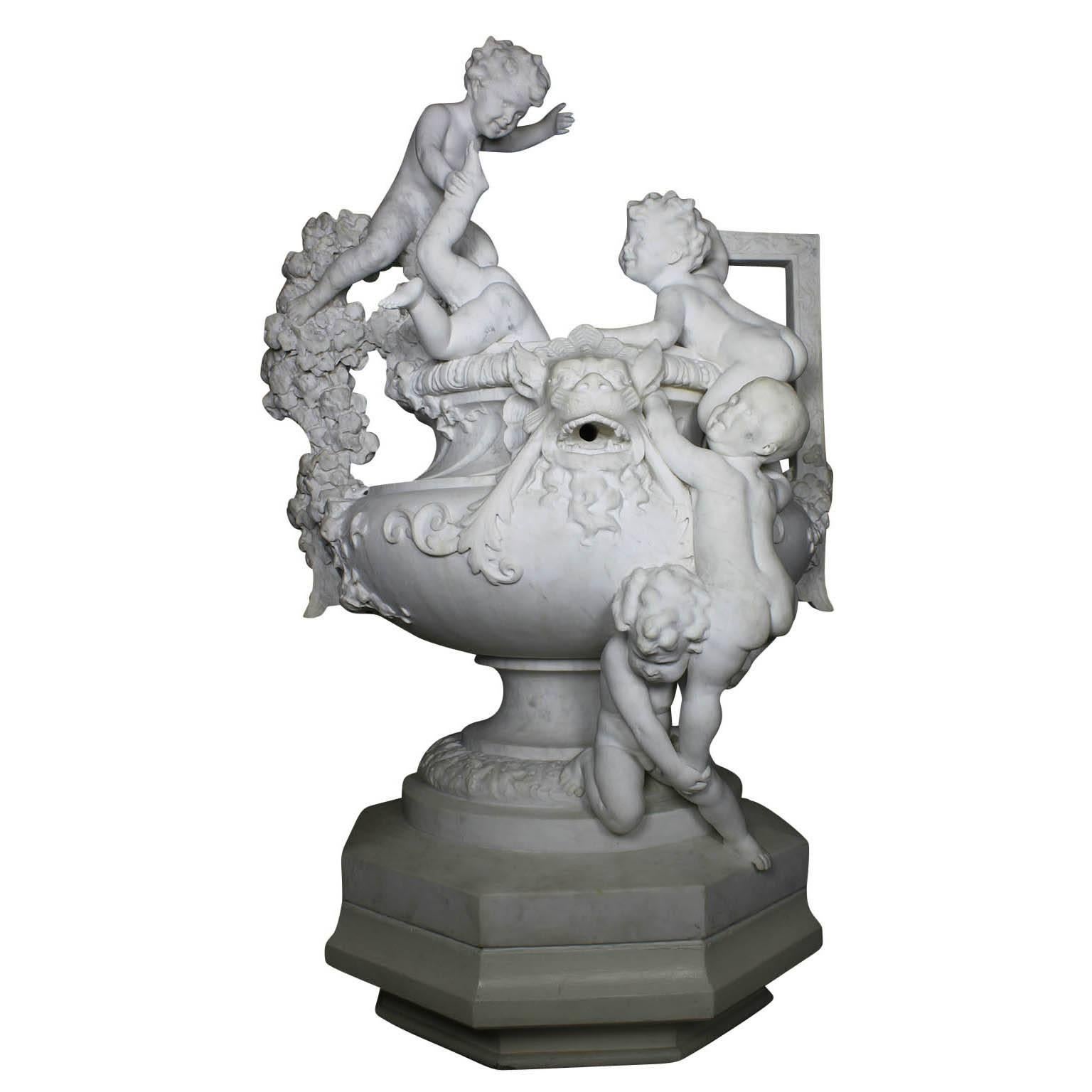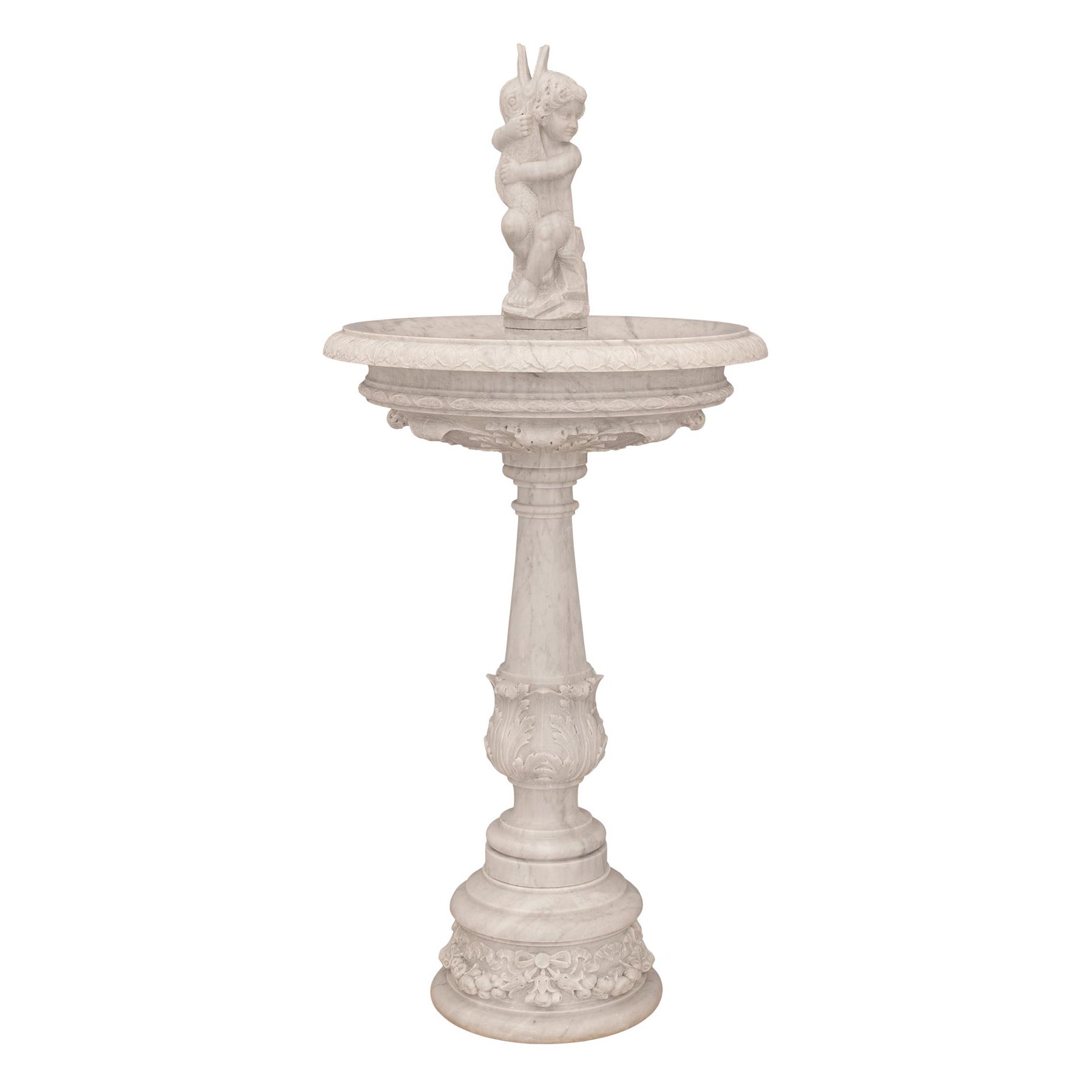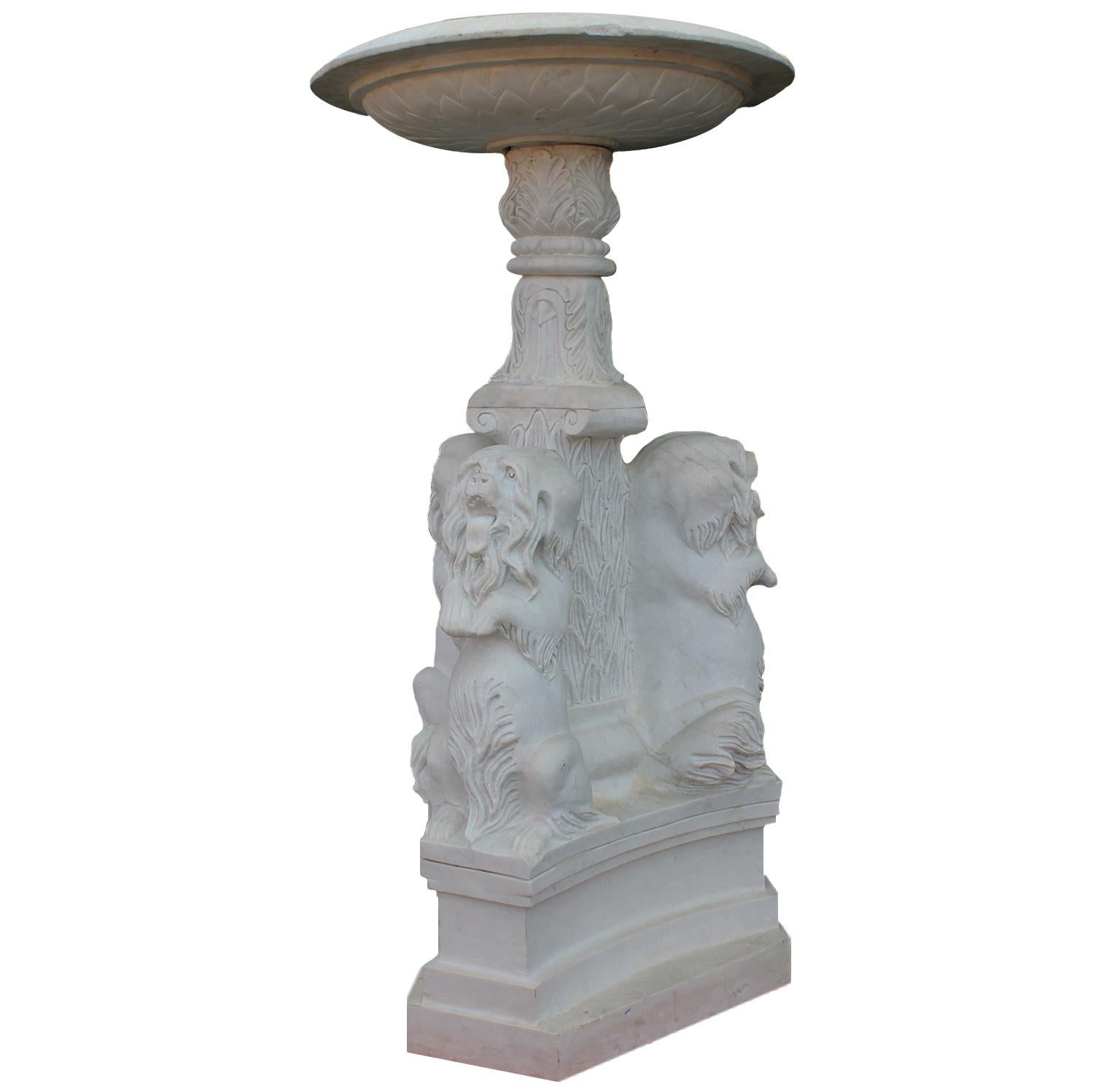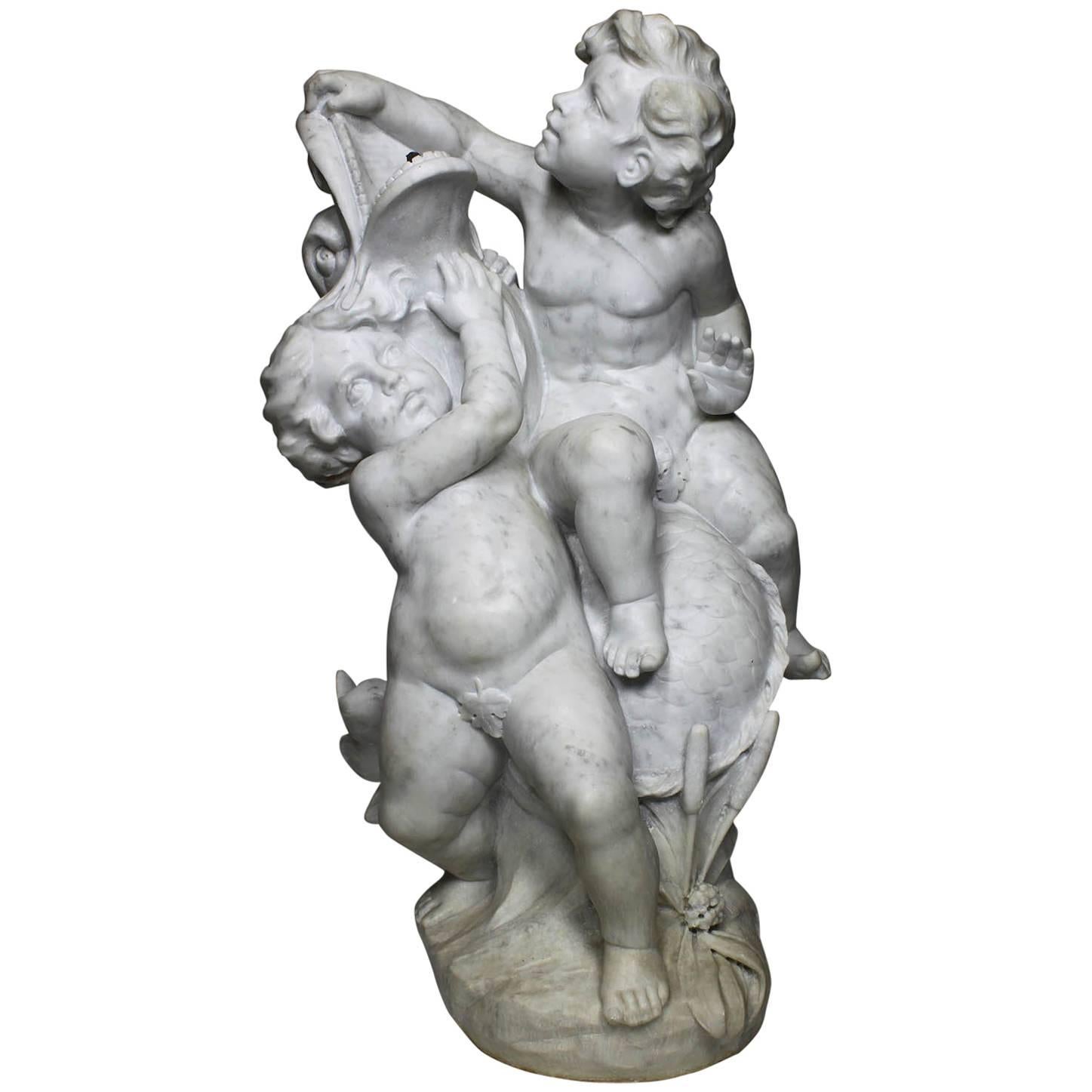Items Similar to Italian 19th Century Carved Carrara Marble Figural Fountain Jardinière Planter
Want more images or videos?
Request additional images or videos from the seller
1 of 11
Italian 19th Century Carved Carrara Marble Figural Fountain Jardinière Planter
About the Item
A very fine Italian 19th century carved Carrara marble figural fountain "Jardinière" modelled as a standing Putto and a Satyr supporting a sea-shell, on a rockwork base (drilled for water). Attributed to Giovanni Battista Lombardi (Italian, 1823-1880). Inscribed: G.B. Lombardi, 1860, circa 1860.
Lombardi's handling of large marble compositions distinguished him from his 19th-century Roman counterparts. His skill was born of his apprenticeship as a young man in his father's marble quarry in Rezzato. Even though Giovanni Battista Lombardi moved to Rome to expand his horizons as an artist, throughout his career much of his work was directed toward his native Brescia. In Rome Lombardi apprenticed under Pietro Tenerari, a follower of Thorvaldsen. Eventually Lombardi established his own studio with his brother Giovita.
Giovanni was the more inventive of the siblings, whereas his brother concentrated mainly on still life and architectural sculpture, he produced Fine portrait busts, commemorative sculpture and large secular and religious commissions.
Lombardi's style is one of Romantic realism with a penchant for orientalist themes. His talent is manifest in his naturalistic marble carving. Lombardi's most prestigious commission was the monument to the Martiri del 1849 for Vittorio Emanuele II in 1862 (Brescia). Many of his emotionally charged female figures are derived from the old testament including Deborah, Ruth, Suzanna or as in the present marble of Rebecca.
Related literature
Vicario, vol. 2, pp. 614 & 619; Panzetta, vol. 1, p.67.
Measure: Height 50 1/2 inches (128.3 cm)
Width 31 inches (78.7 cm)
Depth 26 inches (66.1 cm).
- Attributed to:Giovanni Battista Lombardi (Sculptor)
- Dimensions:Height: 50.5 in (128.27 cm)Width: 31 in (78.74 cm)Depth: 26 in (66.04 cm)
- Style:Baroque (In the Style Of)
- Materials and Techniques:
- Place of Origin:
- Period:
- Date of Manufacture:circa 1860
- Condition:Wear consistent with age and use. A truly beautiful fountain or planter. Great for outdoor or indoor. Condition is very good. Some old water-staining on the Putto and Satyr's chest. Minor discoloration and chips consistent with age and use. Drilled for water connection.
- Seller Location:Los Angeles, CA
- Reference Number:
About the Seller
5.0
Vetted Seller
These experienced sellers undergo a comprehensive evaluation by our team of in-house experts.
Established in 1982
1stDibs seller since 2016
114 sales on 1stDibs
Typical response time: <1 hour
- ShippingRetrieving quote...Ships From: Los Angeles, CA
- Return PolicyThis item cannot be returned.
More From This SellerView All
- French 19th Century Carved Marble Whimsical Figural Urn Fountain with ChildrenBy Joseph Reynés I GurguiLocated in Los Angeles, CAA very fine large, rare and charming, French, 19th century. Belle Époque carved white marble whimsical figural urn fountain depicting children climbing on an urn with flowers and garlands, influenced in the Louis XV style, by Joseph Reynés I Gurgui (Barcelona, 1850-1926). Signed: Reynes. Barcelona, circa 1890. An almost identical Carrara marble fountain also by Josep Reynés carved in 1893 currently at the Parc de la Ciutadella in Barcelona, Spain. Measures: Overall height: 55 inches (140 cm) Marble height: 49 inches (124.5 cm) width: 37 inches (94 cm) depth: 30 inches (76.3 cm) Joseph Reynes Gurguí (Barcelona, 1850 - 1926) is a Catalan sculptor, also known as Reynesy-Gurgui, Spanish school. He studied at the Ecole de la Llotja, studied for a time in Paris, in the workshops of the great French sculptors Jean-Baptiste Carpeaux (1827-1875) and Carrier-Belleuse (1824-1887). He devoted himself mainly to interior decoration. His works were profoundly marked by a French influence. He exhibited in Paris in 1895 where he received an honorable mention. In 1890 he obtained the first medal in Madrid for "The Violinist". Literature: E. Benezit Dictionaire des Peintres, Sculpteurs, Dessinateurs et Graveurs by Grund - Nouvelle Edition, 1976 - Volume 8, Page 714. Cristina Mensoza, Ramon Casas...Category
Antique 19th Century Spanish Louis XV Fountains
MaterialsMarble
- Whimsical English 19th-20th Century White Marble Figural Outdoor Dog FountainLocated in Los Angeles, CAA Whimsical English 19th-20th century white marble figural fountain with dogs fountain. The Baroque Revival six-sided tripod marble base surmounted with three upright seated Yorkshire Terriers resting on a leaf and acanthus center stem, topped with a semi-circular scalloped carved basin...Category
Antique Early 1900s English Baroque Revival Fountains
MaterialsMarble
- A French 19th-20th Century Carved White Marble Fountain Sculpture with ChildrenLocated in Los Angeles, CAA fine and charming French 19th-20th century carved white marble whimsical group sculpture depicting two putti (Children) playing with a dolphin, fitted for use as a fountain, Paris,...Category
Antique Early 1900s French Louis XV Fountains
MaterialsMarble
- An Italian 19th/20th Century Carved Marble Figural Fountain with Children & FishLocated in Los Angeles, CAA Charming Whimsical Italian 19th/20th Century Carved Marble Figural Fountain depicting three playful Putti riding a Koi Fish. Circa: Florence 1900. Step into a realm of enchantment...Category
Antique Early 1900s Italian Belle Époque Fountains
MaterialsMarble
- Large French 19th Century Cast-Iron Fountain Figure of a Seated Nude MaidenBy J.J. Ducel Me de Forges 1Located in Los Angeles, CAA Fine and Large French 19th Century Cast-Iron Fountain Figure Modeled as a Nude Maiden Seated on a Rocky Outcrop Holding a Cornucopia in Her Raised Right Hand, by J.J Ducel. Cast-Signed "J.J. DUCEL Me de FORGES, PARIS". Circa: Paris, 1880. A retailer of fine cast-iron ornaments, J. J. Ducel was recorded as supplying cast-iron works through Paris as early as 1810 in the Pas-de-Calais. The factory was sold in 1878 to the Fonderie de la Haute-Marne and all of the firm's models were subsequently bought by the Val d'Osne foundry. However, prior to the firm's sale, critics at the 1867 Paris Exposition Universelle proclaimed that "Ducel is the great manufacturer of works in cast-iron, to whom Paris is so largely indebted for the grace and elegance that supply so many of the adornments of its streets". Ducel, Val d'Osne and other associated foundries produced both bronze and cast-iron statuary. Cast-iron is corrosive, whereas non-ferrous bronze does not suffer the same detrimental effects of weathering and is therefore a superior and more expensive material. Height: 51 1/2 inches (130.8 cm) Width: 22 inches (55.9 cm) Depth: 30 inches (76.2 cm) The foundry of Val d'Osne became highly regarded for the varied nature and quality of its castings in the second half of the 19th century. Commonly known after 1870 as simply Val D'Osne, the company was originally founded by J.P.V. André in Val d'Osne 1835 and developed rapidly, absorbing smaller foundries in the Haute-Marne area east of Paris. The foundry contributed to the London International Exhibition of 1851, where a bronze fountain cast with classical figures attracted much attention. André also specialised in fancy castings and architectural fittings. His Paris adress was at 14 Rue Neuve, Menilmontant. In 1855 the Barbezat & Cie Foundry was born out of the André workshop. In 1867 Barbezat & Cie changed its name to Houille & Cie. Then, in 1870, it changed its name to Société Anonyme du Val d'Osne. With the change of name came the change of casting mark and adress: Fonderies d'Art du Val d'Osne, 58 Bd Voltaire, Paris or simply Val d'Osne. Cast-iron had been in production during the 18th century but its inferior status to the more fashionable and delicate wrought-iron had generally confined its use to architectural work. By the early 19th century, however, rapid developments of the Industrial Revolution combined with the simultaneous burgeoning of a new middle class provided the impetus for a dramatic expansion in its application and in a short space of time a proliferation of iron foundries across Europe and America thrived on the production of everything from inkstands to railway stations. The use of cast-iron for garden ornament became particularly widespread at this time, as the possibilities for its mass-production at a fraction of the cost of bronze made it the material of choice for indoor/outdoor statuary...Category
Antique 19th Century French Classical Greek Figurative Sculptures
MaterialsIron
- Italian 19th-20th Century Whimsical White Marble Wishing Wellhead with ChildrenLocated in Los Angeles, CAA very fine and exceptionally carved Italian 19th-20th century Baroque Revival style whimsical white Carrara marble wishing wellhead, raised on an octagonal two-step marble base. The intricately carved marble relief circular wellhead depicting carved figures of dancing and cheerful children (Putti) among vines, flowers and fruits, dancing and playing musical instruments with a backdrop of castles, landscapes, forests and wreaths, Florence, circa, 1900. Literature: A similar wellhead was sold by Jan's & Co. Fine French Antiques, Inc. in 1999, provenance the Atkinson/Kirkeby Estate and it is illustrated in "The Estates of Beverly Hills" by Charles Lockwood and Jeff-Hyland, page 150. Another similar is currently on display at the gardens of "The Elms" mansion a public museum part of the Newport Mansions by The Preservation Society of Newport County in Newport, Rhode Island. Yet another similar wellhead carved with frolicking putti with musical instruments and a dentil molded rim is located at Cranbrook House, Bloomfield Hills, Michigan, and is illustrated in B. Israel, Antique Garden Ornament...Category
Antique Early 1900s Italian Baroque Revival Figurative Sculptures
MaterialsCarrara Marble
You May Also Like
- Italian 19th Century White Carrara Marble FountainLocated in West Palm Beach, FLA beautiful and most elegant Italian 19th century white Carrara marble fountain. The fountain is raised by a circular base with a fi...Category
Antique 19th Century Italian Fountains
MaterialsMarble
- Italian 19th Century White Carrara Marble FountainLocated in West Palm Beach, FLA stunning and most important large scale Italian 19th century white Carrara marble fountain. The extremely high quality wall mounte...Category
Antique 19th Century Italian Fountains
MaterialsMarble
- 19th Century Large Circular Garden Fountain Neptune, Italian Limestone FountainLocated in West Palm Beach, FLMonumental antique Italian three-tiered garden fountain. Four Cariatidi surround the center base raising the water which spells from the waved shells. The second tier is supported by...Category
Antique Early 19th Century Italian Baroque Fountains
MaterialsLimestone
- 19th Century French Marble and Bronze FountainLocated in Essex, MA19th century French marble and bronze fountain. Seated satyr on marble column with marble shell basin. Later cast stone plinth. Wonderful garden ele...Category
Antique Late 19th Century French Louis XV Figurative Sculptures
MaterialsMarble, Bronze
- 19th Century Planter Jardinière Antique Fountain Basin, SW FranceLocated in Labrit, LandesAntique French fountain basin can be used as a planter or jardinière This item also may have served of children bath tub Very old, the wood wor...Category
Antique 19th Century French French Provincial Planters and Jardinieres
MaterialsWood
- Italian 19th Century Louis XVI St. White Carrara Marble FountainLocated in West Palm Beach, FLA lovely Italian 19th century Louis XVI st. white Carrara marble fountain. The fountain displays a charming half round basin with a finely sculpted foliate...Category
Antique 19th Century Italian Louis XVI Fountains
MaterialsCarrara Marble
Recently Viewed
View AllMore Ways To Browse
Vittorio Lombardi
Ruth Planter
Antique Calling Card Tray
Atelier Musset
Berrocal Arcimboldo
Chalkware Boy
Chinese Crawling Baby
D G Denmark Figurine
David Fisher Stargazer
Dick Bruna
�mile Louis Picault On Sale
Erte Bronze Angel
Eyeglass Display
Fellerman And Raabe
Formia Cobalt Blue Figurine
Frankart Statue
Franz Rosse
Fraureuth Saxony





